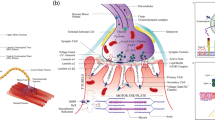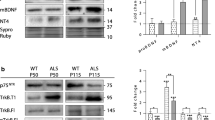Abstract
Amyotrophic lateral sclerosis (ALS) is a progressive incurable neurodegenerative disease with selective loss of lower and upper motoneurons. Dysfunction and destruction of neuromuscular synapses leading to skeletal muscle denervation is one of the early and major events in ALS pathogenesis. Despite of the presence of studies devoted to investigation of neuromuscular transmission in ALS mouse models, no detailed information about molecular mechanisms underlying synaptic dysfunction in ALS and their temporal dynamics during ALS progression is provided. The goal of present work was to study the processes of neurotransmitter release and presynaptic vesicle recycling in neuromuscular synapses of mutated SOD1 (mSOD1) transgenic mice at different clinical stages of disease. Utilizing combination of electrophysiological recording and FM 1–43 (N-(3-triethylammoniumpropyl)-4-(4-(dibutylamino) styryl) pyridinium dibromide) fluorescent imaging, we found that mSOD1 mice at symptomatic and terminal stages of disease showed decreased baseline quantal content of end-plate potentials and prolonged synaptic vesicle recycling time comparing to wild-type mice. Despite the decrease of end-plate potential (EPP) quantal content, studied mSOD1 mice groups showed unchanged dynamics of EPP relative amplitude comparing to WT mice. We also found an increase of miniature end-plate potential amplitude in mSOD1 mice at symptomatic stage, which may reflect compensatory mechanism that alleviates reduction of EPP amplitude. Thus, we provided one of the first detailed characteristics of presynaptic dysfunction at neuromuscular junction in ALS model. Obtained data expand our understanding of the ALS pathogenesis and contribute to stage- and localization-specific description of ALS pathogenetic mechanisms.



Similar content being viewed by others
References
Brown, R. H., & Al-Chalabi, A. (2017). Amyotrophic lateral sclerosis. The New England Journal of Medicine, 377(2), 162–172. https://doi.org/10.1056/NEJMra1603471.
Chio, A., Logroscino, G., Traynor, B. J., Collins, J., Simeone, J. C., Goldstein, L. A., & White, L. A. (2013). Global epidemiology of amyotrophic lateral sclerosis: a systematic review of the published literature. Neuroepidemiology, 41(2), 118–130. https://doi.org/10.1159/000351153.
Therrien, M., Dion, P. A., & Rouleau, G. A. (2016). ALS: recent developments from genetics studies. Current Neurology and Neuroscience Reports, 16(6), 59. https://doi.org/10.1007/s11910-016-0658-1.
Mukhamedyarov, M. A., Petrov, A. M., Grigoryev, P. N., Giniatullin, A. R., Petukhova, E. O., & Zefirov, A. L. (2018). Amyotrophic lateral sclerosis: modern views on the pathogenesis and experimental models. Zhurnal Vyssheĭ Nervnoĭ Deiatelnosti Imeni I P Pavlova, 68(5), 551–566.
Rosen, D. R., Siddique, T., Patterson, D., Figlewicz, D. A., Sapp, P., Hentati, A., Donaldson, D., Goto, J., O’Regan, J. P., Deng, H. X., et al. (1993). Mutations in Cu/Zn superoxide dismutase gene are associated with familial amyotrophic lateral sclerosis. Nature, 362(6415), 59–62. https://doi.org/10.1038/362059a0.
Van Damme, P., Robberecht, W., & Van Den Bosch, L. (2017). Modelling amyotrophic lateral sclerosis: progress and possibilities. Disease Models & Mechanisms, 10(5), 537–549. https://doi.org/10.1242/dmm.029058.
Dupuis, L., & Loeffler, J. P. (2009). Neuromuscular junction destruction during amyotrophic lateral sclerosis: insights from transgenic models. Current Opinion in Pharmacology, 9(3), 341–346. https://doi.org/10.1016/j.coph.2009.03.007.
Moloney, E. B., de Winter, F., & Verhaagen, J. (2014). ALS as a distal axonopathy: molecular mechanisms affecting neuromuscular junction stability in the presymptomatic stages of the disease. Frontiers in Neuroscience, 8, 252. https://doi.org/10.3389/fnins.2014.00252.
Naumenko, N., Pollari, E., Kurronen, A., Giniatullina, R., Shakirzyanova, A., Magga, J., Koistinaho, J., & Giniatullin, R. (2011). Gender-specific mechanism of synaptic impairment and its prevention by GCSF in a mouse model of ALS. Frontiers in Cellular Neuroscience, 5, 26. https://doi.org/10.3389/fncel.2011.00026.
Rocha, M. C., Pousinha, P. A., Correia, A. M., Sebastiao, A. M., & Ribeiro, J. A. (2013). Early changes of neuromuscular transmission in the SOD1(G93A) mice model of ALS start long before motor symptoms onset. PLoS One, 8(9), e73846. https://doi.org/10.1371/journal.pone.0073846.
Elmqvist, D., & Quastel, D. M. (1965). A quantitative study of end-plate potentials in isolated human muscle. The Journal of Physiology, 178(3), 505–529.
Zefirov, A. L., Zakharov, A. V., Mukhametzianov, R. D., Petrov, A. M., & Sitdikova, G. F. (2008). Vesicle cycle in mouse diaphragm motor nerve terminals. Rossiiskii fiziologicheskii zhurnal imeni IM Sechenova, 94(2), 129–141.
Betz, W. J., & Bewick, G. S. (1992). Optical analysis of synaptic vesicle recycling at the frog neuromuscular junction. Science, 255(5041), 200–203.
Betz, W. J., Mao, F., & Bewick, G. S. (1992). Activity-dependent fluorescent staining and destaining of living vertebrate motor nerve terminals. The Journal of neuroscience : the official journal of the Society for Neuroscience, 12(2), 363–375.
Zefirov, A. L., Zakharov, A. V., Mukhametzyanov, R. D., Petrov, A. M., & Sitdikova, G. F. (2009). The vesicle cycle in motor nerve endings of the mouse diaphragm. Neuroscience and Behavioral Physiology, 39(3), 245–252. https://doi.org/10.1007/s11055-009-9122-x.
Zucker, R. S., & Regehr, W. G. (2002). Short-term synaptic plasticity. Annual Review of Physiology, 64, 355–405. https://doi.org/10.1146/annurev.physiol.64.092501.114547.
Zefirov, A. L., & Mukhamed’iarov, M. A. (2004). The mechanisms of short-term forms of synaptic plasticity. Rossiiskii fiziologicheskii zhurnal imeni IM Sechenova, 90(8), 1041–1059.
Banker, B. Q., Kelly, S. S., & Robbins, N. (1983). Neuromuscular transmission and correlative morphology in young and old mice. The Journal of Physiology, 339, 355–377.
Dadon-Nachum, M., Melamed, E., & Offen, D. (2011). The “dying-back” phenomenon of motor neurons in ALS. Journal of molecular neuroscience : MN, 43(3), 470–477. https://doi.org/10.1007/s12031-010-9467-1.
Selkoe, D. J. (2002). Alzheimer’s disease is a synaptic failure. Science, 298(5594), 789–791. https://doi.org/10.1126/science.1074069.
Dauer, W., & Przedborski, S. (2003). Parkinson’s disease: mechanisms and models. Neuron, 39(6), 889–909.
Arendt, T. (2009). Synaptic degeneration in Alzheimer’s disease. Acta Neuropathologica, 118(1), 167–179. https://doi.org/10.1007/s00401-009-0536-x.
Cappello, V., & Francolini, M. (2017). Neuromuscular junction dismantling in amyotrophic lateral sclerosis. International Journal of Molecular Sciences, 18(10). https://doi.org/10.3390/ijms18102092.
Rothstein, J. D. (2009). Current hypotheses for the underlying biology of amyotrophic lateral sclerosis. Annals of Neurology, 65 Suppl 1, S3–S9. https://doi.org/10.1002/ana.21543.
Robberecht, W., & Philips, T. (2013). The changing scene of amyotrophic lateral sclerosis. Nature Reviews Neuroscience, 14(4), 248–264. https://doi.org/10.1038/nrn3430.
Wood, S. J., & Slater, C. R. (2001). Safety factor at the neuromuscular junction. Progress in Neurobiology, 64(4), 393–429.
Nichols, N. L., Gowing, G., Satriotomo, I., Nashold, L. J., Dale, E. A., Suzuki, M., Avalos, P., Mulcrone, P. L., McHugh, J., Svendsen, C. N., & Mitchell, G. S. (2013). Intermittent hypoxia and stem cell implants preserve breathing capacity in a rodent model of amyotrophic lateral sclerosis. American Journal of Respiratory and Critical Care Medicine, 187(5), 535–542. https://doi.org/10.1164/rccm.201206-1072OC.
Nichols, N. L., & Mitchell, G. S. (2016). Quantitative assessment of integrated phrenic nerve activity. Respiratory Physiology & Neurobiology, 226, 81–86. https://doi.org/10.1016/j.resp.2015.12.005.
Lasiene, J., & Yamanaka, K. (2011). Glial cells in amyotrophic lateral sclerosis. Neurology Research International, 2011, 718987. https://doi.org/10.1155/2011/718987.
Funding
The work was supported by Russian Science Foundation (grant #14-15-00847-П). Fluorescent studies within the work were supported by Grant of President of Russian Federation for young doctors of sciences (MD-6877.2018.4).
Author information
Authors and Affiliations
Corresponding author
Ethics declarations
Animal experiment protocols were approved by the Kazan State Medical University Local Ethic Committee.
Rights and permissions
About this article
Cite this article
Mukhamedyarov, M.A., Grigoryev, P.N., Khisamieva, G.A. et al. Dysfunction of Neuromuscular Synaptic Transmission and Synaptic Vesicle Recycling in Motor Nerve Terminals of mSOD1 Transgenic Mice with Model of Amyotrophic Lateral Sclerosis. BioNanoSci. 9, 66–73 (2019). https://doi.org/10.1007/s12668-018-0590-8
Published:
Issue Date:
DOI: https://doi.org/10.1007/s12668-018-0590-8




